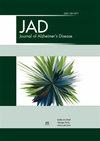探究特发性正常压力脑积水患者视野测试与 CERAD 神经心理测验之间的关联
IF 3.4
3区 医学
Q2 NEUROSCIENCES
引用次数: 0
摘要
背景:视野测试指数与阿尔茨海默病神经心理学电池联盟(CERAD-NB)之间的关系尚不清楚。特发性正常压力脑积水(iNPH)患者为分析提供了一组独特的患者数据。目的:评估视野测试的可靠性:评估使用 CERAD-NB 对 iNPH 患者进行视野测试的可靠性,并研究视野测试结果与认知功能之间的关联。方法:对 62 名可能患有 iNPH 的患者进行全面的眼科检查、眼科光学相干断层扫描成像研究、视野测试和 CERAD-NB。根据视野指数将患者分为两组:不可靠组(19 人)和可靠组(43 人)。对视野测试结果与认知功能之间的关系进行了独立 T 检验分析。非连续变量采用皮尔逊卡方检验。结果显示与可靠组相比,不可靠组在 CERAD-NB 分项测试中表现较差。在 10 个子测试中,有 9 个子测试的差异具有统计学意义,只有 Clock Drawing 没有统计学意义。各组之间的配对比较显示,淀粉样蛋白-β(Aβ)活检、高磷酸化tau活检、载脂蛋白E等位基因或患者的眼科状况之间没有统计学意义。但两组患者的脑脊液 Aβ42 和年龄在统计学上存在显著差异。结论视野测试不可靠的患者在 CERAD-NB 分项测试中表现较差。CERAD-NB 分项测试并没有提供一个具体的临界值,让患者放弃视野测试。是否应该对视野测试不可靠的患者进行认知障碍筛查?本文章由计算机程序翻译,如有差异,请以英文原文为准。
Exploring the Association Between Visual Field Testing and CERAD Neuropsychological Battery in Idiopathic Normal Pressure Hydrocephalus Patients
Background: Association between visual field test indices and The Consortium to Establish a Registry for Alzheimer’s Disease Neuropsychological Battery (CERAD-NB) is unknown. Idiopathic normal pressure hydrocephalus (iNPH) patients provide a unique set of patient data for analysis. Objective: To assess the reliability of visual field testing using the CERAD-NB in patients with iNPH and to investigate the association between visual field test results and cognitive function. Methods: 62 probable iNPH patients were subjected to comprehensive ophthalmological examination, ophthalmological optical coherence tomography imaging studies, visual field testing, and CERAD-NB. Based on visual field indices, the patients were divided into two groups: unreliable (n = 19) and reliable (n = 43). Independent T-test analysis was performed to examine the relationship between visual field test results and cognitive function. Pearson Chi-square test was used for non-continuous variables. Results: The unreliable group performed worse in CERAD-NB subtests compared to the reliable group. Statistically significant differences were observed in nine out of ten subtests, with only Clock Drawing showing no statistical significance. Pairwise comparison of the groups showed no statistical significance between amyloid-β (Aβ) biopsy, hyperphosphorylated tau biopsy, apolipoprotein E allele or the ophthalmological status of the patient. But there was a statistically significant difference in cerebrospinal fluid Aβ42 and age between the groups. Conclusions: Patients with unreliable visual field tests performed worse on CERAD-NB subtests. CERAD-NB subtests do not provide a specific cut-off value to refrain patients from visual field testing. Should patients with unreliable visual field tests be screened for cognitive impairment?
求助全文
通过发布文献求助,成功后即可免费获取论文全文。
去求助
来源期刊

Journal of Alzheimer's Disease
医学-神经科学
CiteScore
6.40
自引率
7.50%
发文量
1327
审稿时长
2 months
期刊介绍:
The Journal of Alzheimer''s Disease (JAD) is an international multidisciplinary journal to facilitate progress in understanding the etiology, pathogenesis, epidemiology, genetics, behavior, treatment and psychology of Alzheimer''s disease. The journal publishes research reports, reviews, short communications, hypotheses, ethics reviews, book reviews, and letters-to-the-editor. The journal is dedicated to providing an open forum for original research that will expedite our fundamental understanding of Alzheimer''s disease.
 求助内容:
求助内容: 应助结果提醒方式:
应助结果提醒方式:


